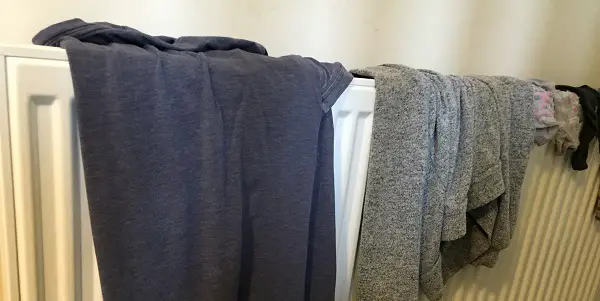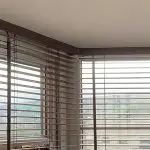The DIY Fix is reader supported. When you buy after clicking a link on our site, we may earn an affiliate commission.
The average household produces more than 20 litres of moisture per day. This comes from a combination of sources including:
- Bodily functions, such as breathing and sweating.
- Cooking
- Bathing
Another way that you can add moisture to the air, is by drying clothes indoors. This is commonly achieved by hanging clothes on radiators around the house or using an airer placed in front of a radiator.

Drying clothes on radiators can have a significant impact on the levels of moisture in your property. As your clothes dry, the moisture in them will evaporate into the air. This process is also assisted by the temperature of the air. The warmer it is, the more moisture air can hold.
As a result, you end up with a considerable amount of water vapour. If this is not released, it will settle on surfaces as condensation. Over time this could lead to damp issues inside your property.
Condensation is the opposite of evaporation. When you are drying your clothes on a radiator, the water evaporates into the air. Condensation is the reverse of this process; it is when the water vapour condenses and turns back into liquid water.
Condensation occurs in a property, when the warm, moist air hits a colder surface. This could be a window, a mirror, a wall, or any other surface with a lower temperature than the air around it.
A good example of this happening would be a cold drink on a hot day. The can or glass will quickly form water droplets all over its surface. This is moisture in the air condensing as the cold surface of the drink acts as a dew point.
Can drying clothes on radiators cause long term damp problems?
It is rare for drying clothes indoors to cause major damp problems. However, if it is a regular activity and there are no precautions taken, it can build up over time.
Condensation is the most common form of damp in UK properties. Most homes are producing large amounts of moisture, but they are very inefficient at removing it from the air.
Overtime, certain areas of your property will be subjected to prolonged condensation and this can create more serious damp and mould problems.
One of the most common side effects of condensation damp is black mould (Stachybotrys Chartarum). This is a form of fungus that thrives in properties with levels of high humidity.
Overtime, black mould can grow and spread to different areas of a property. It releases airborne spores when disturbed. These are microscopic and can easily attach themselves to surfaces and quickly spread.
Black mould can also pose health risks, as the spores are toxic. This can be an issue for people with underlying health issues or respiratory conditions.
Some common symptoms of black mould exposure can be seen below:
- A runny nose
- Difficulty breathing and shortness of breath
- Red puffy eyes
- Skin irritation
- Nausea
- And in some cases, fever
Ideally black mould should be removed as soon as you find it. This can be done by washing surfaces down with bleach and hot water.
Alternately, you can use a black mould remover. Click here to see a popular option.
How to stop damp when drying clothes on the radiator
Drying clothes on a radiator is not an ideal solution. However, in some cases it is the only solution we have. When the weather outside is not suitable for drying, then drying your clothes indoors is the only option.
So how do you stop damp and condensation if you do have to dry your clothes indoors on the radiator?
The only way to stop condensation occurring is to remove the excess moisture from the air. This can be achieved by improving ventilation and air circulation. There are several ways this can be achieved which can be seen below:
- Open windows – This option may seem counter intuitive, especially if it is cold and the heating is helping to warm your house. However, opening a window is probably the easiest way to release moisture and allow new fresh air to circulate in.
One good idea is to isolate all your drying to one smaller room. This should be easier to maintain a reasonable temperature, even with the window open. Plus, it will avoid moisture moving through your property and causing condensation in other areas. - Extractor fans – An extractor fan can be a very effective way of removing moisture from the air. They are most common in bathrooms, kitchens, and utility rooms. But if you do not already have one installed, they are quite affordable.
In most cases you will need to hire an electrician to install an extractor fan for you. This is a quick process that can be done in one visit. You will usually end up paying the cost of the fan, plus the electrician’s day rate for labour. - A dehumidifier – This is another good option. It also does not require installation and you can leave the windows closed. Dehumidifiers work by drawing air from the room and passing it over a refrigerated coil. This causes the water to condense and collect in the dehumidifiers internal collection bucket.
Alternatives to drying clothes on the radiator
There are alternatives to drying your clothes that will avoid condensation and damp. The most obvious is drying your clothes outside. Obviously, this is not always an option, but even in cooler weather, outdoor drying can still be effective. It may just take slightly longer.
Unfortunately, UK weather is unpredictable and when it is cold and wet, outdoor drying is not an option.
A good second option is a tumble dryer. This will also need to vent moist air outside to avoid condensation. Alternatively, you could opt for a condensing dryer, which condenses the moisture and collects it internally.
The only downside to a tumble dryer is cost. However, running your central heating is not free. So, whether you use your radiators or a tumble dryer there will be a financial cost.
Conclusion
As you can see, drying clothes on your radiators can cause damp. It is not always the best solution, but in some cases, it is the best option available.
The main thing you must remember, is to keep your room well ventilated when you use this method of drying. The damp caused by drying clothes on the radiator is usually quite minor, but it can build up over time. A few simple precautions will ensure that the level of condensation produced is much lower.
Finally, where possible dry outside. It is not an option in winter, but during summer months it is obviously the best way to dry clothes. Plus, for most of Spring and Autumn you will be able to achieve dry clothes outside on the line.




